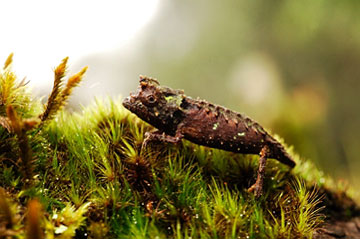Madagascar signs big carbon deal to fund rainforest conservation
Madagascar signs big carbon deal to fund rainforest conservation
Rhett A. Butler, mongabay.com
June 11, 2008
Madagascar will sell more than nine million tons of carbon offsets to fund rainforest conservation in a newly established protected area. Conservationists say the deal will protect endangered wildlife, promote sustainable development to improve the economic well-being of people living in and around the park area, and help fight global warming.
In a ceremony in Madagascar’s capital city of Antananarivo, the government of Madagascar signed an agreement with the Makira Carbon Company (MCC), a company established by the Bronx Zoo-based Wildlife Conservation Society (WCS), a conservation group that helped set up the Makira Forest protected area. MCC will aim to sell the forest carbon offsets to entities abroad who seek to purchase “high-quality emissions reductions delivering multiple benefits — climate change mitigation, biodiversity conservation, and sustainable economic development,” according to a statement from WCS.

A Brookesia chameleon on some moss in Makira. Photo by Julie Larsen Maher, staff photographer of WCS. |
The deal is based on the concept of avoided deforestation whereby tropical countries are compensated for the value of carbon stored in forests that would otherwise be released into the atmosphere by deforestation. Makira, which covers some 400,000 hectares, likely stores upwards of 400 million tons of carbon dioxide (109 million tons of carbon). The forest also provides clean water to roughly 300,000 people and houses 22 species of lemur, hundreds of bird species, and thousands of plant varieties. More than three-quarters of Madagascar’s biodiversity is unique to the island.
“The agreement between WCS and the Government of Madagascar has a ‘triple bottom line’: it ensures forests and wildlife are protected, local people benefit and climate change is mitigated,” said Dr. Steven E. Sanderson, President and CEO of the Wildlife Conservation Society.

Deforestation in Madagascar. Photo by Rhett A. Butler How much is deforestation in Madagascar worth? How much is deforestation in Madagascar worth in the carbon market? It all depends on the emergence of a market for forest carbon. Right now avoided deforestation offsets only qualify for voluntary markets like the Chicago Carbon Exchange where they go for around $3 per ton of CO2. For comparison, in the legally binding European market, EU allowances (EUAs) go for more than $30 per ton. Still given the vast amount of carbon released by deforestation in Madagascar on a yearly basis, the carbon market could prove to be a lucrative way to finance conservation efforts in the country. The U.N. Food and Agriculture Organization (FAO) estimates that deforestation of woodlands and forests in Madagascar resulted in the loss of 159 million tons of carbon (583 million tons of CO2) between 1990 and 2005. At $3 per ton of CO2 this carbon would have had a market value of $1.75 billion — a substantial sum in a country where most of the population lives on less than $1 per day. If forest carbon were priced at the same price as carbon on European exchanges, the carbon value of ecosystem degradation in Madagascar would approach $17.5 billion for the 15-year period. How WCS calculated the value of Makira’s carbon Winrock International, an NGO focused on sustainable use and management of natural resources, set a “without project” baseline rate of deforestation in 2004 at 0.149 percent per year, with a gradual increase over the life of the project (30 years) to 0.2 percent. The “with project” rate of deforestation decreases to 0.07 percent by 2014 and remains at that level through 2034. The difference between the “with” and “without project” rate of deforestation accounts for the emissions reductions. Winrock assumed per-hectare carbon dioxide emissions from deforestation at 1,000 tons based on its carbon stock analysis at Makira and from measurements in other parts of the country. |
“The signing of this accord on the sale of carbon credits constitutes a tremendous first and shows the commitment of the Government of Madagascar to lead conservation of biodiversity in Madagascar, and at the same time, ensure the long term financing for the sustainable development and sustainable management of protected areas,” added Harrison Randriarimanana, Madagascar Minister of Environment, Water, Forests, and Tourism. “In partnership with WCS, the Government of Madagascar will sell the carbon credits and use the funds for supporting biodiversity conservation and the economic development of Madagascar.”
Avoided deforestation blossoming
While avoided deforestation — also known as REDD or Reducing Emissions from Deforestation and Degradation — was explicitly excluded from the Kyoto Protocol, policymakers meeting at climate talks in Bali, Indonesia last December signaled that forestry would play a role in future emissions mitigation schemes.
Even though forest credits fetch only 10-20 percent of what conventional carbon credits trade for in legally binding markets, several avoided deforestation initiatives have been announced since the Bali conference, including projects in Mantadia, Madagascar (Conservation International); Noel Kempff Mercado National Park, Bolivia (The Nature Conservancy); Aceh, Indonesia (Carbon Conservation and Fauna & Flora International); and Papua, Indonesia (New Forests), among other sites. Conservationists say avoided deforestation offers one of the most cost-effective ways to protect both forests and climate, while tropical governments (including a “Coalition of Rainforest Nations” led by Costa Rica and Papua New Guinea) see the concept as a way to fund sustainable development and anti-poverty initiatives in their countries.
WCS’s Makira announcement comes just days before the opening of a new Madagascar exhibit at the Bronx Zoo. The exhibit — housed in the first landmark building in New York to receive a Leadership in Energy and Environmental Design (LEED) gold certification — will showcase the African island’s remarkable biodiversity, including ring-tailed lemurs, chameleons, spider tortoises, and tomato frogs.
More news on avoided deforestation














